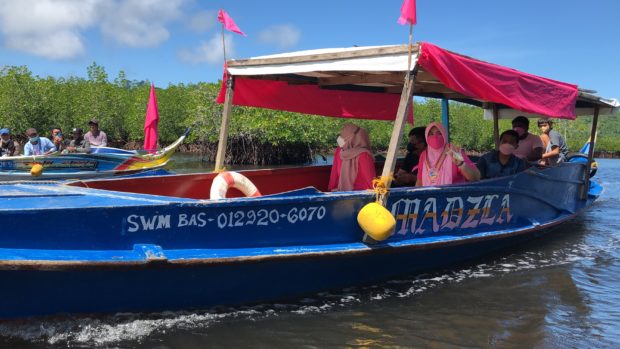
Vice President Leni Robredo leaves Isabelan City’s island village of Marang-Marang aboard a motorized banca. Robredo expressed her amazement at the villagers’ efforts to protect the mangrove areas on the island. @alipalajulieINQ
ISABELA CITY — When Vice President Maria Leonor “Leni” Robredo went to Isabela City in Basilan last March 17, she had to take a motorized banca to cross the sea from Barangay Tabiawan to reach the mangrove-covered island barangay of Marang-Marang.
Although the island village is just a 20-minute ride across the sea, people there still consider it an isolated island, a place rarely visited by high government officials.
So isolated was the island that the locals joked that even the coronavirus had not be able to penetrate, protected as they were by the mangroves that grew in abundance.
“No one got sick here, not even our elder people, because we always got the sun and the sea for everyone,” said Nacida Angko, 33, a single parent of two children.
Thus, it was a breath of fresh air when the sunny village for the first time had to receive and welcome a guest such as the vice president of the country.
“This is our first time here to be visited by a national leader,” she said. “I don’t even remember elected national officials coming to our place before.”
The 20-minute ride afforded the presidential aspirant a glimpse of the mangroves covering the picturesque island, where she talked to a gathering of women mostly belonging to the Sama Bangingi, Tausug, Badjao and Yakan indigenous groups.
“We are thankful that you came to visit our island, not only the mangroves,” Satra Hamad-Janang, adviser of the Marang-Marang Women’s Association, told Robredo.
Claudio Ramos II, the city tourism officer of Isabela City, described Marang-Marang as a village of 2,097 people, surrounded and protected by mangroves and accessible by small vessels like motorboats.
Houses on stilts
Women make up almost half of the people in the area, where fishing, gathering clams, shrimps, squids and other aquatic resources—as well as mat weaving—are main source of livelihood.
Janang described her community as a fishing village, where men go fishing in the morning while the women earn extra income by preparing home cooked native delicacies to guests in a nearby floating cottages.
She also described the 1,000-hectare island as quite isolated from the town center, where some houses were on stilts.
BRIDGE OF HOPE. For Musli Jumli the 500-meter span of the newly constructed bridge that links Marang-Marang Island to Isabela City’s mainland barangay of Malamawi, spells hope for the future. Growing up in Marang-Marang, he used to swim to the
mainland just to go school. @alipalajulieINQ
It was only in 2021 when the construction of the P10.21 million concrete bridge was finished that the island was finally connected to this city’s Malamawi village in the Basilan mainland, she added.
“We witnessed the difficulties of villagers here, especially among students going to school,” said Deputy Speaker Mujiv Hataman, who initiated the project.
Musli Jumli, 53, head of the barangay tanods, called the 500-meter concrete bridge as “bridge of hope” for easing travel to the main Basilan island for the more than 2,000 villagers who live in Marang-Marang.
“Before, we used to swim to go to school,” Jumli said. “We had to swim to cross the sea from our island and reach the mainland. We swim towards mangrove areas, where we had to walk through 200-meters of mangroves before reaching Malamawi. There, we start dressing up for school, it’s another trek to school,” Jumli told the Inquirer.
He said the community got used to swimming everyday because they had to. “Everyone here is a swimmer (because) if you can’t swim, you could not see the nearest village nor attend classes there,” he added.
Jumli said four of his six children experienced the ordeal that he and his wife went through. “But at least, my two youngest children are now enjoying this bridge. They still have to swim to harvest food in the mangrove, though,” he added.
Along the 500-meter stretch of the bridge are also the big water pipes bringing fresh water to the village.
“We used to buy water from the mainland,” said Jumli. “It was costly and heavy. Now, we have a faucet and tap water. The villagers need not pay that much to go to school, go to the market and to buy water. I see more people buying bicycles and motorbikes. These things were impossible years ago,” Jumli said.
“Now, I don’t have to worry about my two daughters crossing the water. I have more time to focus on my little sari-sari store here,” said Angko.
Hataman said they made sure to complete the bridge during the pandemic so that when face-to-face classes starts, the children no longer had to swim to go to school. The bridge is also expected to spur economic activities as fisher folks can now easily deliver fresh catch to the fish market in Malamawi.
Robredo committed not just fishing boats but also solar freezers for the village of Marang Marang.
She said she wanted to continue the development that had already been started there.
“Marami nang pagbabago sa Basilan. Yung pagbabago papunta sa katahimikan at kabutihan, sana tuloy tuloy na ito, pagtulungtulungan natin (There are already lots of development in Basilan, the kind of development towards peace , we hope that it will continue. We will help each other),” she said.
RELATED STORY:
Robredo courts Bangsamoro vote